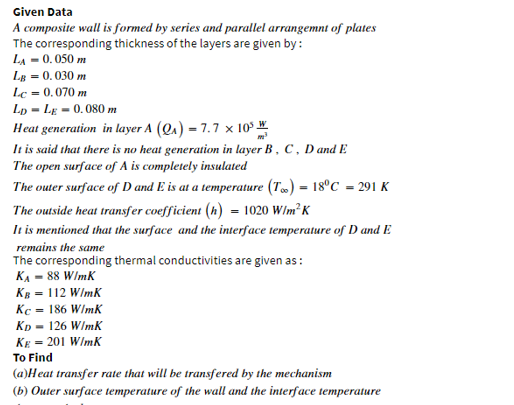The flat wall given below is formed by the series and parallel arrangement of layers A, B, C, D and E. The thicknesses of A, B, C layers are 50 mm, 30 mm and 70 mm, respectively, and the thicknesses of D and E layers are equal and 80 mm. There is a uniform heat generation of 7.7x105 W/m3 in layer A, and there is no heat generation in layers B, C, D and E. The surface of the A surface open to the atmosphere is completely insulated. The air at 18 oC is continuously supplied from the outer surface of the D and E layers (h= 1020 W/m2.K) to cool it. The interface and surface temperatures of the D and E layers are the same. a) Calculate the heat transfer rate that will be transferred by the mechanism. b) Calculate the outer surface temperatures of the wall and the interface temperatures between the layers. Thermal conductivities:k₁= 88 W/m K, kB = 112 W/mK, kc = 186 W/m K, kp= 126 W/m K, KE=201 W/m K
The flat wall given below is formed by the series and parallel arrangement of layers A, B, C, D and E. The thicknesses of A, B, C layers are 50 mm, 30 mm and 70 mm, respectively, and the thicknesses of D and E layers are equal and 80 mm. There is a uniform heat generation of 7.7x105 W/m3 in layer A, and there is no heat generation in layers B, C, D and E. The surface of the A surface open to the atmosphere is completely insulated. The air at 18 oC is continuously supplied from the outer surface of the D and E layers (h= 1020 W/m2.K) to cool it. The interface and surface temperatures of the D and E layers are the same. a) Calculate the heat transfer rate that will be transferred by the mechanism. b) Calculate the outer surface temperatures of the wall and the interface temperatures between the layers. Thermal conductivities:k₁= 88 W/m K, kB = 112 W/mK, kc = 186 W/m K, kp= 126 W/m K, KE=201 W/m K
Introduction to Chemical Engineering Thermodynamics
8th Edition
ISBN:9781259696527
Author:J.M. Smith Termodinamica en ingenieria quimica, Hendrick C Van Ness, Michael Abbott, Mark Swihart
Publisher:J.M. Smith Termodinamica en ingenieria quimica, Hendrick C Van Ness, Michael Abbott, Mark Swihart
Chapter1: Introduction
Section: Chapter Questions
Problem 1.1P
Related questions
Question

Transcribed Image Text:The flat wall given below is formed by the series and parallel arrangement of layers A, B, C, D and E.
The thicknesses of A, B, C layers are 50 mm, 30 mm and 70 mm, respectively, and the thicknesses of
D and E layers are equal and 80 mm. There is a uniform heat generation of 7.7x105 W/m3 in layer A,
and there is no heat generation in layers B, C, D and E. The surface of the A surface open to the
atmosphere is completely insulated. The air at 18 oC is continuously supplied from the outer surface of
the D and E layers (h= 1020 W/m2.K) to cool it. The interface and surface temperatures of the D and E
layers are the same. a) Calculate the heat transfer rate that will be transferred by the mechanism. b)
Calculate the outer surface temperatures of the wall and the interface temperatures between the layers.
Thermal conductivities:KA = 88 W/mK, KB 112 W/mK, kc 186 W/m K, kp= 126 W/m K,
KE 201 W/m K
A
B
C
D
E
50 cm
3 m.
Expert Solution
Step 1

Step by step
Solved in 3 steps with 6 images

Recommended textbooks for you

Introduction to Chemical Engineering Thermodynami…
Chemical Engineering
ISBN:
9781259696527
Author:
J.M. Smith Termodinamica en ingenieria quimica, Hendrick C Van Ness, Michael Abbott, Mark Swihart
Publisher:
McGraw-Hill Education

Elementary Principles of Chemical Processes, Bind…
Chemical Engineering
ISBN:
9781118431221
Author:
Richard M. Felder, Ronald W. Rousseau, Lisa G. Bullard
Publisher:
WILEY

Elements of Chemical Reaction Engineering (5th Ed…
Chemical Engineering
ISBN:
9780133887518
Author:
H. Scott Fogler
Publisher:
Prentice Hall

Introduction to Chemical Engineering Thermodynami…
Chemical Engineering
ISBN:
9781259696527
Author:
J.M. Smith Termodinamica en ingenieria quimica, Hendrick C Van Ness, Michael Abbott, Mark Swihart
Publisher:
McGraw-Hill Education

Elementary Principles of Chemical Processes, Bind…
Chemical Engineering
ISBN:
9781118431221
Author:
Richard M. Felder, Ronald W. Rousseau, Lisa G. Bullard
Publisher:
WILEY

Elements of Chemical Reaction Engineering (5th Ed…
Chemical Engineering
ISBN:
9780133887518
Author:
H. Scott Fogler
Publisher:
Prentice Hall


Industrial Plastics: Theory and Applications
Chemical Engineering
ISBN:
9781285061238
Author:
Lokensgard, Erik
Publisher:
Delmar Cengage Learning

Unit Operations of Chemical Engineering
Chemical Engineering
ISBN:
9780072848236
Author:
Warren McCabe, Julian C. Smith, Peter Harriott
Publisher:
McGraw-Hill Companies, The